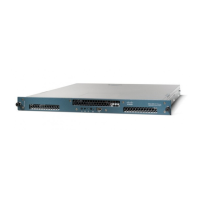5-7
Cisco 4700 Series Application Control Engine Appliance Administration Guide
OL-11157-01
Chapter 5 Managing the ACE Software
Saving Configuration Files
Viewing Configuration Files
To display the ACE running-configuration file associated with the current context,
use the show running-config command in Exec mode. Configuration entries
within each mode in the running-configuration file appear in chronological order,
based on the order in which you configure the ACE. The ACE does not display
default configurations in the ACE running-configuration file.
Note The write terminal command can also be used to display the ACE
running-configuration file. The write terminal command is equivalent to the
copy running-config command.
To view the content of the running- and startup-conf
iguration files, use the
following commands:
• To view the running-configuration file, use the show running-config
command.
• To view the startup-configuration file, use the show startup-config
command.
The syntax for the sho
w startup-config command is as follows:
show startup-config
The syntax for the sho
w running-config command is as follows:
show running-config [aa
a | access-list | action-list | class-map | context |
dhcp | domain | ft | interface | parameter-map | policy-map | probe |
resource-class | role | rserver | serverfarm | sticky]
The keywords and options are:
• aaa—(Optional) Displays AAA information.
• access-list—(Optional) Displays access control list (ACL) information.
• action-list—(Optional) Displays action list information.
• class-map—(Optional) Displays the list of all class maps configured for the
current context. The ACE also displays configuration information for each
class map listed.
• context—(Optional) Displays the list of contexts configured on the ACE. The
ACE also displays the resource class (member) assigned to each context. The
context keyword works only from within the Admin context.

